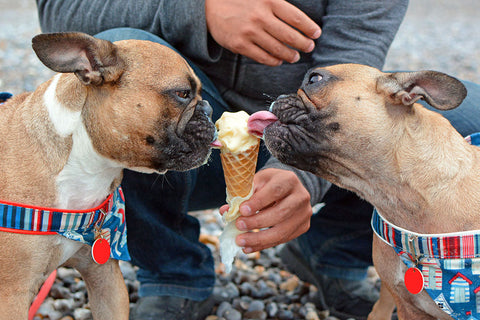
Oh no! You can smell your dog coming from a mile away! What do you do when your dog gets
sprayed by a skunk?
Forewarned is Forearmed
As you can assume, the best way to combat dealing with skunk spray is to avoid it!
Your dog is more likely to be sprayed in the warmer weather months, and especially around dawn or dusk as skunks are generally nocturnal creatures. However, it’s important to know that skunks are also out and about in the early fall as they try to fatten up before winter.
While skunks don’t hibernate, they are pretty inactive during winter and live off of their fat stores so it’s important for them to forage for food before winter – leading them to your garbage cans or outside compost piles at times.
Keep your yard tidied up as much as possible; patch up any holes in your backyard fence and tightly secure the lids on your garbage cans. Even so, prevention is not a sure thing. Whether a skunk slinks into your yard or your dog accidentally finds one on a hike, the potent spray of a skunk is no laughing matter at the time.
When to See Your Vet
Skunks can spray up to 15 feet and tend to aim for the head; if this irritant gets in your dog’s eyes it can act like tear gas and cause damage to the sensitive eye tissues. If it gets in his mouth and he swallows it, this may induce nausea and vomiting. If your dog is having any reaction, it’s best to get him in to the emergency clinic as soon as possible. No need to fret – this is actually a vary common situation vets deal with. After a visit to the dog doctor, the next step is to get the skunk secretion off.
How to Remove Skunk Spray – the Do’s and Don’ts
DON’T:
- Spray your dog down with water; skunk spray is an oil so it will settle into fur very quickly and easily. Water will only spread the skunk odor around and likely enhance the already awful odors.
- Attempt to use home remedies like tomato juice or distilled vinegar; let’s just be honest…they’re not going to work.
DO:
- Carry a skunk combatant or keep it handy, especially if you live in an area where skunks are more common or in any rural area.
- If you don’t have any skunk combatant on hand, there is one recipe that you can mix up yourself. Forget the tomato juice – we’re talking:
-
- 1 quart hydrogen peroxide solution (preferably 3%)
- ¼ cup baking soda
- 1 – 2 teaspoons of dish detergent
Stir all three ingredients together and (while still foaming) apply it all over your dog wherever she’s been hit by the skunk spray. Rub it deeply into her coat – all the way to her skin; follow with a thorough rinse of clean water. The baking soda and peroxide work together to neutralize the odors while the dish soap breaks down the oil.

Special Notes: Wear gloves to avoid getting the oil on your own hands. Also be extremely cautious not to get any of the solution in her eyes, nose and mouth. Additionally, be aware that peroxide is a bleach and may discolor your dog’s coat as well as your clothing.
After using the combatant or the DIY recipe, it’s time to shampoo! Once you’ve fully washed all skunk oil from your dog, she’ll need a regular bath. You know the drill: lather up thoroughly, rinse well, and repeat. Be gentle during the numerous washings and expect your dog’s skin to be a bit drier for a few days due to the vigorous cleansing.
Call Your Favorite Pet Place – The Barkery!
Whether you wash at home or only use the combatant, set up a grooming appointment at the Barkery and Bath and let us handle the mess for you! No need to chase your dog around the yard for bathtime – and we’re pretty sure you don’t want a skunky dog inside your house! While your dog gets a bath, you can pick out a new toy or some treats as a little consolation reward! The Barkery and Bath has got your back - give us a call or stop by today!



